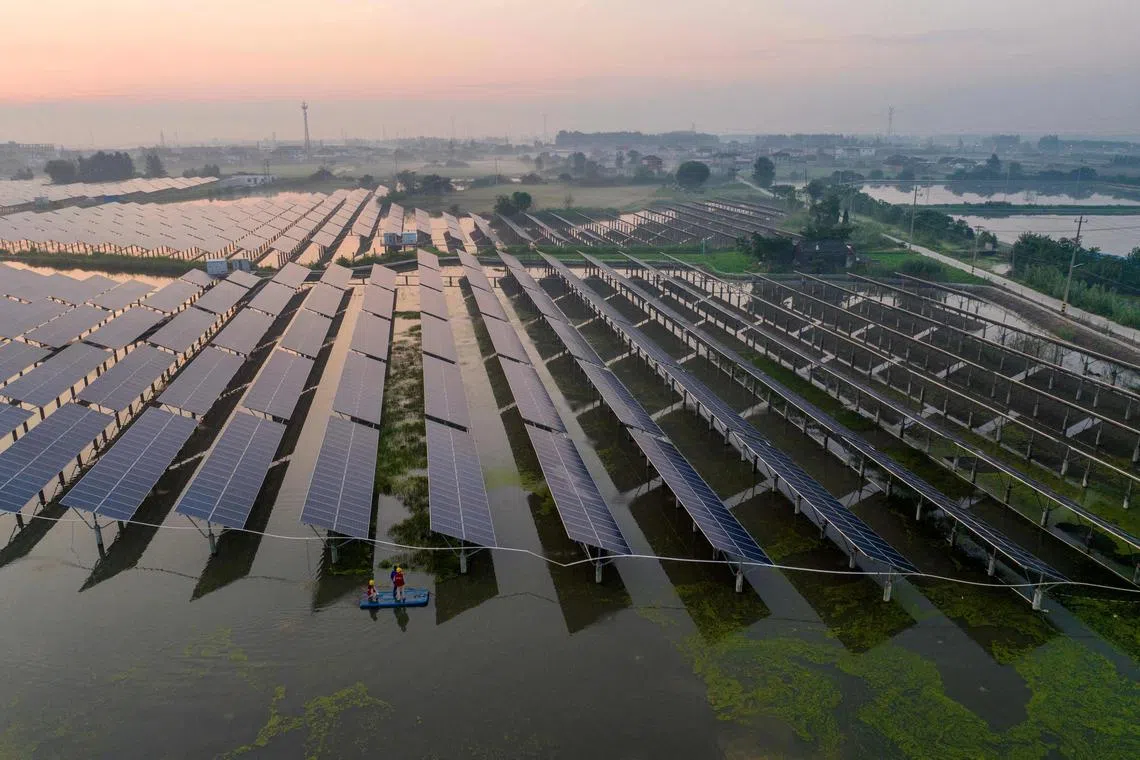China leaves everyone behind in race for renewables income
Sign up now: Get ST's newsletters delivered to your inbox

A solar power station in in Taizhou, in China’s eastern Jiangsu province.
PHOTO: AFP
Follow topic:
New York - The biggest US companies are badly trailing their Chinese counterparts when it comes to generating income from solar, wind, nuclear and other types of renewable energy.
Companies that make up the S&P 500 produce just 3.4 per cent of their revenue from clean energy sources, which is roughly half what companies on the Shanghai Composite Index earn, according to BloombergNEF.
With corporations struggling to make the transition to net-zero emissions, analysts at BNEF looked under the hood of more than 8,000 companies to determine how much of their revenue is attributable to clean energy.
“Shifting business models toward greener activities is about more than being virtuous for the sake of the planet,” said BNEF analyst Michael Daly. “There’s a huge financial opportunity for companies that help drive the energy transition.”
Chinese companies such as solar leaders Longi Green Energy Technology and Tongwei are benefiting from the nation’s dominant position in the clean energy supply chain.
In fact, the largest number of clean energy equity investment opportunities are in the Asia-Pacific region, according to BNEF.
The Asia-Pacific region has more than 680 companies that draw more than half their revenue from clean energy, which includes renewable and nuclear power, electrified transport, biofuels, hydrogen and carbon capture, BNEF estimates.
That compares with closer to 410 companies in the United States and roughly 430 in Europe, the Middle East and Africa combined.
The opacity of company reports makes uncovering clean energy exposures a major challenge, Mr Daly said.
For instance, most large oil and gas companies do not break out clean energy revenue as a standalone category.
And some, such as fossil fuel giants Exxon Mobil and Marathon Petroleum, provide no information whatsoever about any proceeds from clean energy activities.
Unsurprisingly, almost all renewable energy manufacturers and developers derive most of their revenue from clean energy, which earns them an A1 rating from BNEF, led by companies including Contemporary Amperex Technology of China and Denmark’s Vestas Wind Systems.
By comparison, 45 per cent of electric utilities tracked by the research company are rated A1.
Electricitie de France generated almost 70 per cent of its revenue in 2022 from nuclear power, with additional income from hydro, wind and solar sources, according to BNEF.
Italy’s Enel has a more balanced set of clean power generation revenue and ranks just behind EDF and Sweden’s Vattenfall among the world’s largest utilities with the highest clean energy exposure.
In the automotive sector, Tesla and China’s BYD are the clear leaders, far ahead of traditional carmakers such as BMW and Ford Motor, according to BNEF.
Looking forward, Mr Daly said: “We expect the latter group – traditional carmakers – to raise its electric vehicle (EV) exposure, as more models are released and new policies supporting the EV roll-out are introduced.” BLOOMBERG

